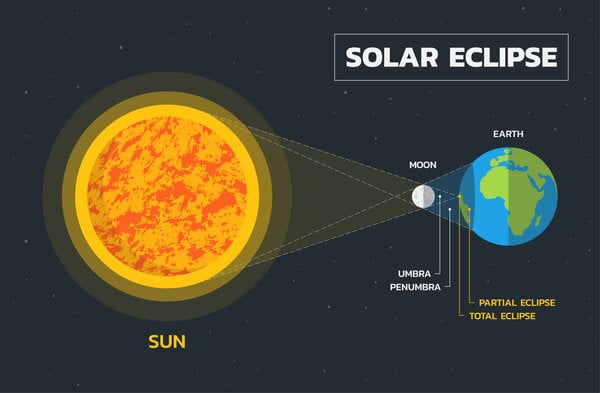On April 8, 2024, a rare total solar eclipse will grace North America, traveling from Mexico’s Pacific coast and making its way northeast, crossing the U.S. from Texas to Maine. The celestial phenomenon will also cast its shadow over the Canadian provinces of New Brunswick and Newfoundland.
This event holds particular significance for Brennan Industries, a leading provider of hydraulic fittings, deeply embedded in the aerospace industry. As leaders in aerospace technology, we're dedicated to creating new and advanced solutions.
The mysteries of the ionosphere and space weather
A solar eclipse is much rarer than a lunar eclipse, occurring as the moon passes between the sun and earth. It casts a shadow on the earth along its path and consists of two concentric cones: a lighter outer shadow known as the penumbra and a darker inner shadow known as the umbra. The sun will be entirely blocked for observers within the path of the central umbra, encompassing Brennan’s corporate office in the Cleveland, Ohio, area. 
During a total solar eclipse, scientists can study the corona of the sun's atmosphere to learn more about solar winds and coronal mass ejections—significant quantities of charged particles released from the sun at high velocity. This knowledge is crucial for understanding the impact of solar storms on earth.
Through the study of these events, we can acquire valuable insights that aid in preparation and mitigation of their effects on the earth’s ionosphere, the upper layer of the earth’s atmosphere. The impact on the ionosphere during a solar eclipse is due to the sudden reduction in solar radiation. Containing ions and electrons (charged particles), the ionosphere plays a vital role in refracting and reflecting radio waves, thereby influencing radio communications and navigation systems.
According to physicist Phillip Erickson, during daylight the ionosphere is “charged” because “energy from the sun and its corona feeds extreme ultraviolet photons, creating free electrons and ions.” A solar eclipse essentially acts like a light switch for the ionosphere as the moon passes in front of the sun, allowing scientists to study atmospheric changes in real-time. Being able to study these changes provides insight into how the ionosphere affects space weather and communications.
Cleveland’s pivotal role in NASA’s innovation journey
NASA is the original mother of invention in space exploration, and eclipses are a major event for their research. The organization studies the effect of solar eclipses in our atmosphere and space, and how they influence solar and earth science.
Cleveland, Ohio, has a longstanding connection with NASA and the aerospace industry. Our region proudly hosts an impressive $3.2 billion cluster of aerospace component engineering and production. It serves as the home base for the NASA Glenn Research Center, the Neil A. Armstrong Test Facility, and accommodates a significant number of aerospace OEMs and tier suppliers – including, of course, our own presence.
As a major supplier to the aerospace industry, Brennan’s ISO 9001, AS9100D and NADCAP certifications mean our fittings are qualified for use in civilian and military aerospace applications. This ensures we maintain the highest manufacturing standards, which is why aerospace OEMs and tier suppliers from around the globe look to us for their fluid connections.
Challenges and adaptations for pilots and orbiting spacecraft
While solar eclipses don't significantly impact pilots, they can present challenges for orbiting spacecraft. Aircraft pilots, during the eclipse period, anticipate nighttime landing conditions. Navigating through the path of totality, where the sky darkens, like the trajectory of an upcoming lunar eclipse, pilots experience conditions that resemble dusk or dawn, occasionally giving the appearance of overcast skies. Despite this, it's a nonissue for planes accustomed to flying by instrument flight rules at night. However, awareness is crucial, as passing in or near an eclipse might otherwise lead pilots to perceive an otherworldly journey into the Twilight Zone. 
Additionally, certain orbiting spacecraft, like NASA's solar-powered Lunar Reconnaissance Orbiter, face a power outage as they enter the moon’s shadow, encountering similar effects when passing through the earth’s shadow during a lunar eclipse. To conserve energy, mission controllers execute a partial shutdown on some satellites during solar or lunar eclipses. However, satellites designed for continuous operation can seamlessly switch to battery power. If their orbit aligns with the earth's dark side during the eclipse, the duration spent in the earth's shadow may extend to as much as 70 minutes during the equinox.
Chasing shadows: Brennan’s celestial celebration
A solar eclipse is obviously a big deal, and they only occur over the same regions about every 330 years. For those who will experience the total eclipse on April 8, it will begin to pass over at Mexico’s Pacific coast at around 11:07 a.m. PDT and exit on the Atlantic coast of Newfoundland, Canada, at 5:16 p.m. NDT.
Cleveland, Ohio, will be situated directly in the center of the eclipse's path. According to NASA data, the eclipse is scheduled to commence in the Cleveland area at 1:59 p.m., reaching maximum totality at 3:15 p.m. Brennan Industry's headquarters, located in a Cleveland suburb, will host a "Totality Viewing Party" for employees, expressing gratitude for everyone's dedication to excellence, both in the workplace and beyond our planet.
Amidst the spectacle, be sure to exercise caution by shielding your eyes with NASA-certified solar eclipse glasses. And remember, don't blink; even if you find yourself directly in its path, the total eclipse will last only about 4 ½ minutes. So, make sure not to miss it!
Discover the depth of Brennan's expertise in aerospace hydraulics by exploring our essential aerospace content, featuring resources, certifications and more.


